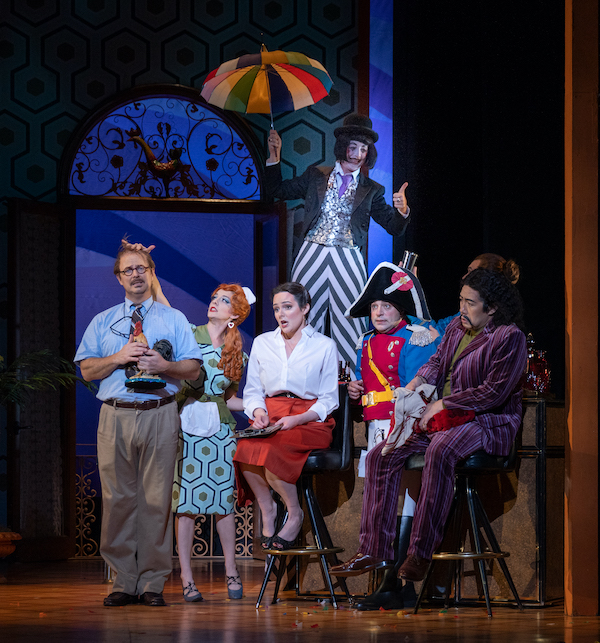Utah Opera returns with zany, colorful staging of Rossini’s “Barber”

A woman on stilts and a dream ballet featuring human-sized chickens were just two of the zany surprises welcoming Utah Opera’s audience Saturday night for its season-opening production of Rossini’s The Barber of Seville. The extras also included naughty nuns, Napoleonic soldiers throwing confetti, and a recurring chicken and rooster motif that is never explained.
Set designer Shoko Kamburra and costume designer Amanda Seymour created a colorful, carnival-esque world evoking mid-century modern design and 1960s fashion, but deviating enough to be wholly original. Combined with director Michael Shell’s frenetic, broadly comic staging, the production was a joyful pastiche, reminding audience members of a certain age of Rowan & Martin’s Laugh-In.
The production worked because it accentuated the sparkling silliness of Rossini’s music and Cesare Sterbini’s libretto. The opera tells the story of a count who, with the help of his barber, disguises himself as a poor student, soldier, and eventually a music teacher to woo a woman who is kept under lock and key by her guardian, a doctor who intends to marry her. The characters’ machinations don’t make much sense under scrutiny, and it’s never quite clear why the count—who is powerful enough to avoid arrest at one point by revealing his identity to the police—doesn’t just announce himself and his intentions at the beginning.
Featuring some of the most famous and beloved tunes in all of opera, Rossini’s sublime score appears to wink at the plot’s ridiculousness, as he shamelessly showcases his own skill and those of the singers in a dizzying array of reprises and ensembles that—though de rigueur in the bel canto style—do little to advance the plot. Shell, Kamburra, and Seymour—all making their Utah Opera debuts – match Rossini’s shamelessness, filling the space Rossini gives them with camp and pratfalls that astonish at every turn.
While he played the title role with an easy charisma and excellent comic timing, Michael Adams’ rendition of Figaro’s opening aria “Largo al Factotum” lacked vocal power and a few times, he was drowned out by the orchestra. However, he did find his voice as the evening progressed.
As Rosina, Sarah Coit was captivating. Her opening aria “Una voce poco fa” displayed a clear, natural tone and her phrasing – and that of the orchestra under the able baton of Gary Thor Wedow – was exquisite. Throughout the evening, her voice was in the service of her character, drawing the audience in to empathize with Rosina’s plight.
As Almaviva, tenor Matthew Grills also impressed with a clear, natural tone, and the compatibility of the romantic leads’ voices added to their chemistry. His sweet rendition of “Se il mio nome”) which he sings to Rosina outside her window, won over the audience as well as his intended.
Perhaps the biggest laughs were earned by Matthew Burns as Doctor Bartolo, who played the role like a hapless dad in a late 1960s sitcom. He threw himself into his role’s physical comedy while still singing his baritone role with precision and gusto. In this production, he was an optometrist and Rosina was his assistant. At one point Shell decided to have them administer an eye exam to a frightened patient as they argue in recitative, and both deftly handled the complicated physical comedy, without losing a note or flourish.
This production cast Don Basilio as a strutting Italian pop singer, which Adam Lau played broadly, sometimes holding a pretend microphone and doing an Elvis-style bump and grind as his rich, bass voice glided easily over Rossini’s score. His rendition of “La Calunnia” (“slander”) was one of the evening’s musical high points, and his character’s duplicity and confusion created an excellent foil to Adams as Figaro.
Rounding out an excellent cast, Julia Gershkoff added laughs with her earthy, somewhat seductive portrayal of Doctor Bartolo’s servant Berta, delivering a charming rendition of her comic aria.
From the opening downbeat of the overture, Wedow captured the score’s wit, refinement, and energy, deftly phrasing the quiet parts and buzzing under the raucous ensembles.
The zenith of the zany staging was Count Almaviva’s scene disguised as a music teacher. Wearing vertical-striped lime and forest green pants, a floral blouse, love beads, and a leather vest and carrying a sitar, the Count sings “Pace y gioia” (“peace and happiness”) as he brushes past Dr. Bartolo and his servants, spreads out a yoga mat, and proceeds to sage the room. He then launches into yoga sun salutations and is in the middle of a downward dog pose, when Dr. Bartolo finally asks who he is, addressing the count’s derriere. Though campy, the scene remained true to the meaning of the scene in the original opera—and the extra elements accentuated laughs that were already intended.
The Barber of Seville runs through October 17 at the Janet Quinney Lawson Capitol Theatre. usuo.org